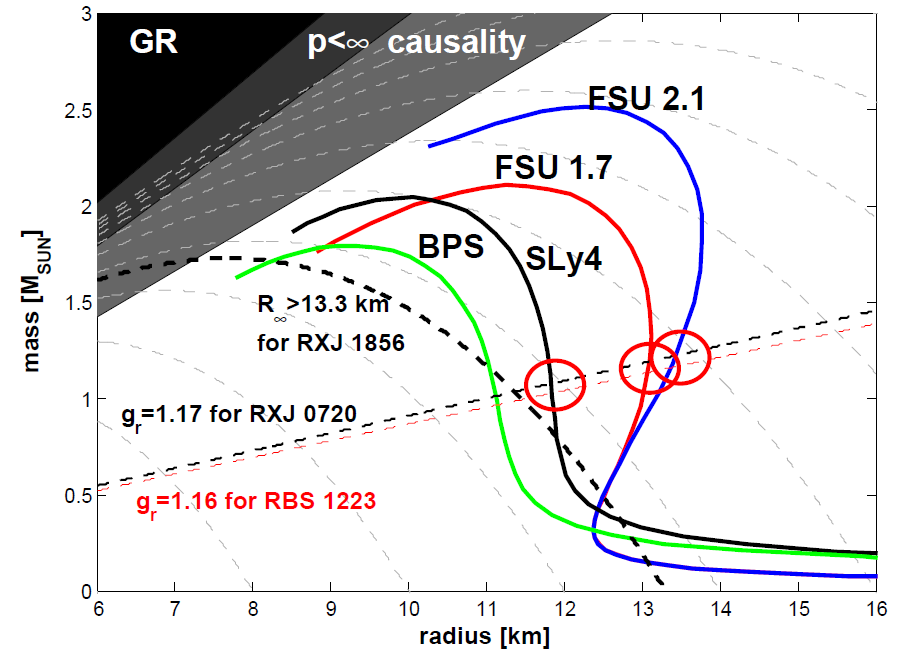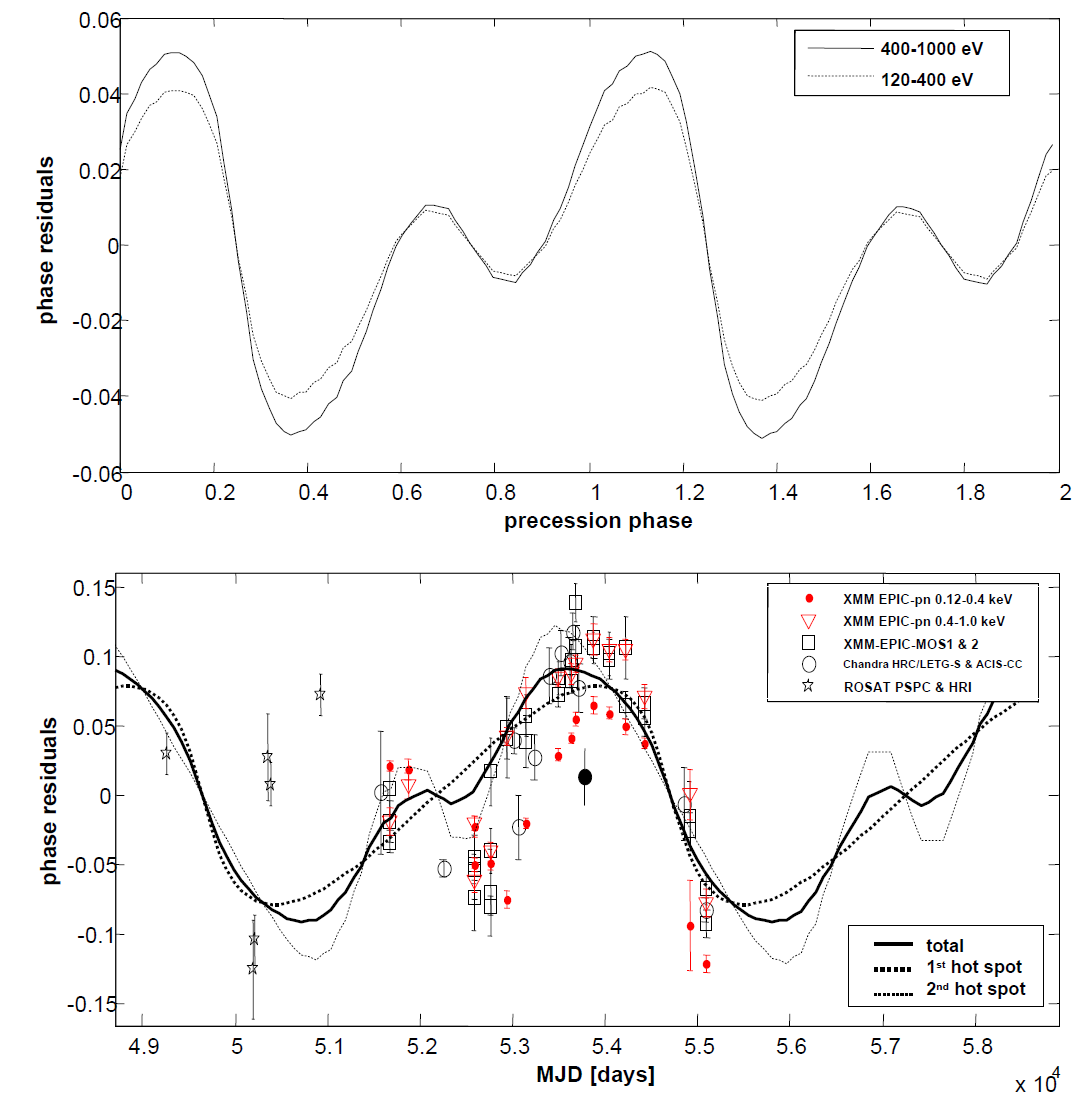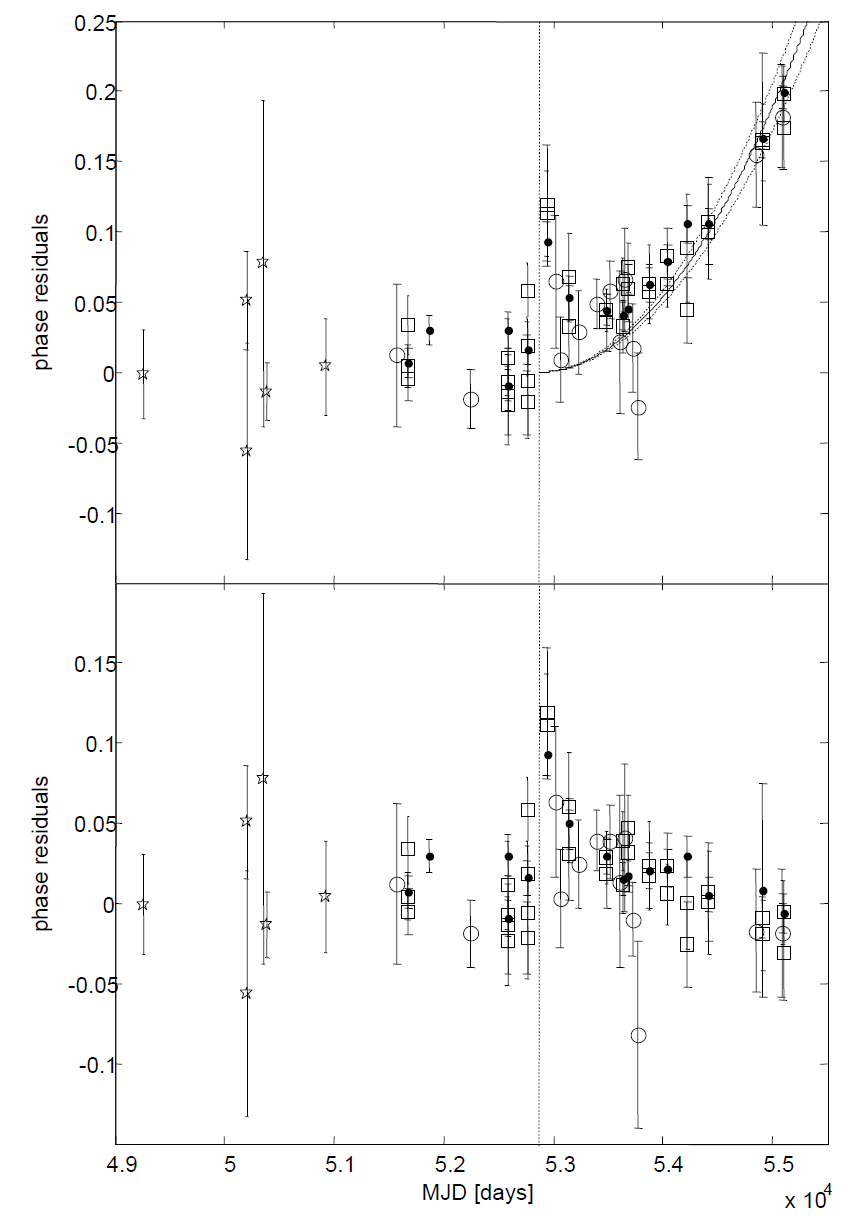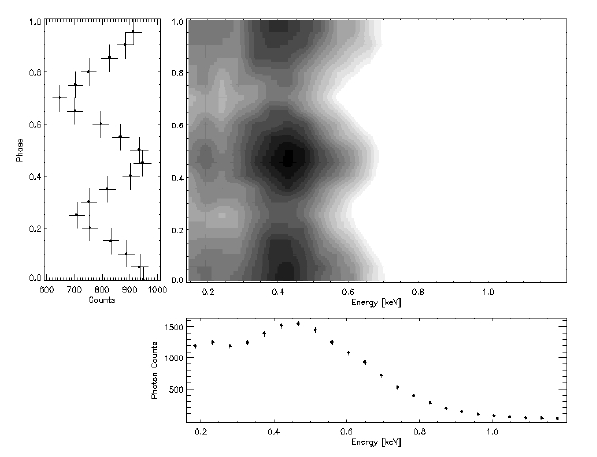Constraining the Equation of State of neutron stars from X-ray observations
Matter at high pressure and densities (1015 g/cm3), large magnetic fields (1013 G) and high temperatures (106 K) cannot be generated in laboratories. To study the properties of matter under such extreme conditions, in particular the equation of state (EoS) at super nuclear densities, one needs suitable objects, hence neutron stars (NSs). The EoS can be constrained by the mass-radius relation (the compactness), period and long term evolution of the period (glitch, free precession) and cooling behaviour. Current NS models deal with various families of EoS, i.e. with strange stars (quark stars or stars with pion and/or kaon condensates), NSs with ordinary neutrons mixed with protons and electrons (stiff EoSs yielding larger radii and soft EoSs yielding smaller radii; both in conjunction with or without superfluid matter).
Suitable targets for such investigations are the so-called “Magnificent Seven” (M7), a group of young, isolated X-ray pulsars with large magnetic fields, that are radio-quiet and nearby (Haberl, 2007) with blackbody emission and the “Three Musketeers” (3M), that emit as one or two blackbodies in the X-ray with a power-law tail at higher energies (de Luca et al., 2005) and are known as radio sources.
Compactness from spectral lines
Due to gravity, spectral lines appear redshifted, hence offer us the opportunity to measure the compactness. Hambaryan et al. 2009, A&A 497, L9 found an absorption feature at 569 eV in the co-added RGS spectra of the M7 RX J0720, that would either fit to the Kα lines of He-like oxygen (OVII), mixed with absorption lines from OVI at rest (ISM), or to the Lyα line of OVIII with a grav. redshift gr=1.17. Then, OVII would appear at 480 eV with the same redshift. Maybe such a line is found in the co-added HRC spectra of RX J0720 (Hohle et al., 2012, MNRAS). Van Kerkwijk et al. (2004) found a similar feature at 576 eV in the co-added RGS spectra of RX J1605, that could be confirmed by us. The features in the spectra of both NSs would fit to the different transitions of OVII at rest (1s2p1P1@573.95 eV and 1s2p3P1,2@568.63 eV), however it is not clear, why always one transition should be suppressed and vice versa and the transition at 568.63 eV appears in absorption - not in emission (alternatively, these lines are caused by redshifted OVIII Lyα absorption with slightly different compactness). We investigated the spectra of the other M7 and 3M (see below and Hohle et al., submitted) – some NSs exhibit these lines, whereas in some cases these lines are absent. Currently it is not known whether the absorption features are caused by the ISM, a circumstellar cloud/disk or from the NS atmosphere. A cloud/disk would account for some properties of the so-called optical excess in the case of RX J0720 (Hambaryan et al., 2009) .
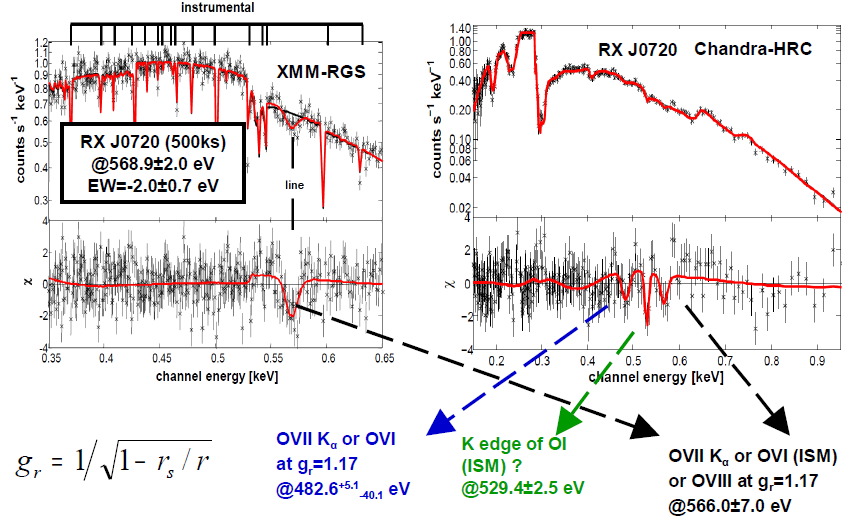
Left: Co-added RGS1 spectra of RXJ0720 with the absorption feature at 0.57 keV (see Hambaryan et al. 2009, A&A 497, L9 and Hohle et al., 2012, MNRAS). Right: Narrow absorption features found in the co-added Chandra HRC-S/LETG spectra of RXJ0720. These lines are not seen in the co-added spectra of the much brighter (and longer exposed) M7 RXJ1856. The line centres correspond to 0.48 keV, 0.53 keV (neutral oxygen from the ISM) and 0.57 keV (see Hohle et al., 2012, MNRAS).
Radius from optical and X-ray data
Using the modified Stefan-Boltzmann law, it is possible to derive the radius of a NS, if temperature and distance is known. The temperature can be measured from X-ray observations (XMM/Chandra), whereas the determination of the distance is challenging. We determined updated values of the parallaxes of the two M7 RX J1856 (Walter et al., 2010) and RX J0720 (Eisenbeiß 2011, PhD thesis) using HST observations, yielding distances of 123+11-15 pc and 278+210-84 pc, respectively. The X-ray spectra deliver the size of the emitting area, i.e. the hot spots (not the NS radius). Together with the optical magnitudes (~25-27 mag; emission from the cooler regions of the NS), we used a two component model with different temperature profiles (figure below) to determine the radius. Most likely the radii have values of R∞ around 17+/-3 km, that would obey a stiff EoS, see below.
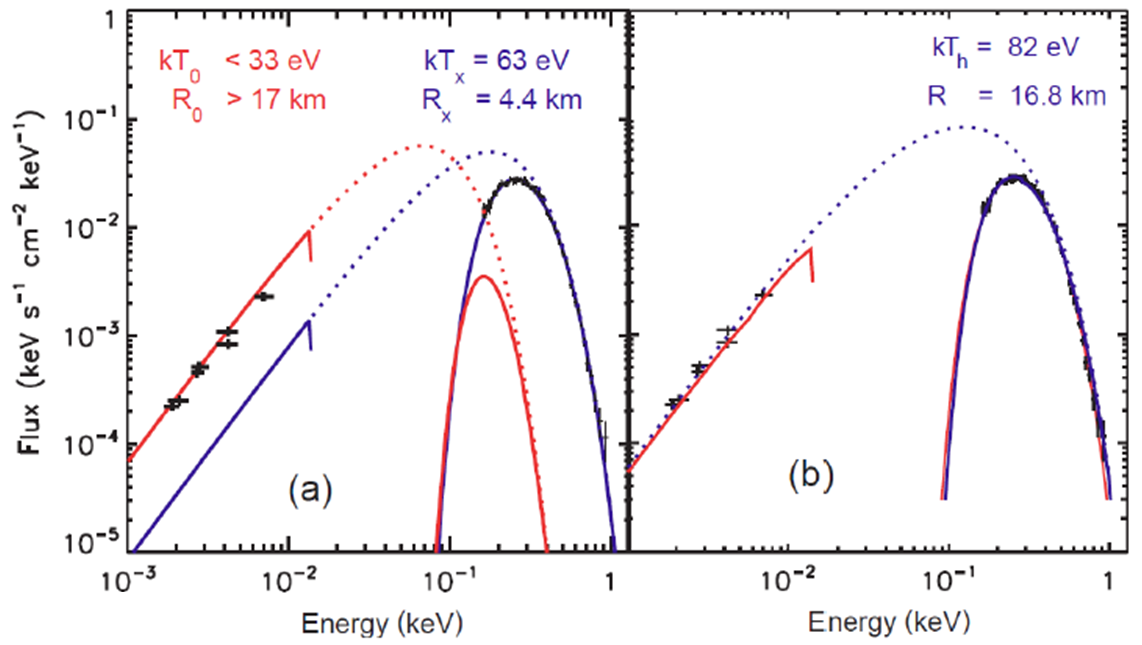
M/R diagram with stable configurations of mass and radius of some EoS (references below). The upper left regions are excluded by rs (GR), central pressure less than infinity and (p<∞) and that the speed of sound in the object does not exceed the speed of light in vacuum (causality). Our measurements yield a lower limit for R∞>13.3 km for RXJ1856 (black dashed line from parallax measurements) and from (possible) red-shifted OVIII lines in the co-added RGS and Chandra spectra of RXJ0720 (see figure above) gr=1.17 (black dashed line). For RBS 1223 M/R = 0.087 (Hambaryan et al. 2011, A&A), hence gr=1.16 (red dashed line). These values are consistent with EoSs in the M/R diagram that are indicated by red circles. Hence, we can exclude the BPS EoS and all EoSs dealing with strange matter (see also Lattimer 2010).
FSU & NL
G. Shen, C. J. Horowitz, S. Teige, Phys. Rev. C 82, 045802 (2010)
G. Shen, C. J. Horowitz, S. Teige, Phys. Rev. C 82, 015806 (2010)
G. Shen, C. J. Horowitz, S. Teige Phys. Rev. C 83, 035802 (2010)
SLy EoS from Hänsel & Potekhin, 2004 A&A
X-ray timing: Free precession and glitches
The X-ray pulsar RX J0720 exhibits long term variations of its spectral and temporal properties, that is unique among all NSs. These variations can be caused by a glitch (van Kerkwijk et al., 2007) or free precession (Haberl et al., 2006, Hohle et al., 2009, A&A 498, 811). If the NS is composed of a superfluid interior, free precession should be damped after 100-1000 cycles (Link, 2003). On the other hand, the precession period and the spin period yield the ellipticity of the NS, that is a cruical input for population syntheses of objects that emit detectable gravitational waves.
Based on the observations available at 2009 we created a model of a free precessing NS with different emission geometries, taking all general relativistic effects into account, as well as an updated glitch model (see Hohle 2011, PhD thesis and Hohle et al., 2010, A&A 521, 11 for the glitch model), by fitting the phase residuals. The precession model yield a long term period of 14 years for the best fit.
Upper panel: Phase residuals that exhibit a double hump with different size and a variable phase shift between hard and soft photons, like observed for RXJ0720. The phase residuals were obtained for the magnetic temperature profile with two antipodal hot spots, where T1 = 90 eV and T2 = 82 eV, i = 90°, θ = 20° and θw = 30°.
Lower panel: Best fit of the phase residuals for the XMM Newton EPIC-pn observations (hard band) derived with T1 = 126 eV and T2 = 101 eV, Ξ1 = 17.3° and Ξ2 = 34.5°, i = 80°, θ = 14.9° and θw = 27.4. The two hot spots (Gaussian temperature profile) are not exactly antipodal, θoff = 7.6° and φoff = -5.4°. The fitted precession period is 13.87 yrs (Hohle 2011, PhD thesis).
Upper panel: The phase residuals of RXJ0720 after applying the glitch solution in van Kerkwijk et al. (2007). The glitch time tg = 52866 days is marked as dotted vertical line. According to the phase evolution due to spin-down, the deviant points after tg are fitted with an error wighted parabolic slope (solid line, dotted parabolic lines indicating the 1σ confidence range.) corresponding to a post-glitch correction of fdotc = -1.11(10) x 10-17 Hz/s.
Lower panel: The phase residuals after applying the post-glitch fdot correction. Symbols as above (Hohle et al., 2010, A&A 521, 11).
Phase resolved spectroscopic study of the isolated neutron stars
To constrain the mass-to-radius ratio of isolated neutron stars, we performed spin-phase resolved X-ray spectroscopic analysis. The data from all observations of RBS 1223 conducted by XMM-Newton EPIC pn with the same instrumental setup in 2003-2007 were combined to form spin-phase resolved spectra. A number of complex models of neutron stars with strongly magnetized (Bpole ~ 1013 − 1014 G) surface, with temperature and magnetic field distributions around the magnetic poles, and a partially ionized hydrogen thin atmosphere above it have been implemented into the X-ray spectral fitting package XSPEC for simultaneous fitting of phase-resolved spectra. A Markov-Chain-Monte-Carlo (MCMC) approach is also applied to verify results of fitting and estimating in multi parameter models.
The spectra in different rotational phase intervals and light curves in different energy bands with high S/N ratio show a high complexity. The spectra can be parameterized with a Gaussian absorption line superimposed on a blackbody spectrum, while the light curves with double-humped shape show strong dependence of pulsed fraction upon the energy band (13%– 42%), which indicates that radiation emerges from at least two emitting areas.
A model with condensed iron surface and partially ionized hydrogen thin atmosphere above it allows us to fit simultaneously the observed general spectral shape and the broad absorption feature observed at 0.3 keV in different spin phases of RBS 1223. It allowed to constrain some physical properties of X-ray emitting areas, i.e. the temperatures (Tp1 ~ 105 eV, Tp2 ~ 99 eV), magnetic field strengths (Bp1 ~ Bp2 ~ 8.6 × 1013 G) at the poles, and their distributions parameters (a1 ~ 0.61, a2 ~ 0.29, indicating an absence of strong toroidal magnetic field component). In addition, it puts some constraints on the geometry of the emerging X-ray emission and gravitational redshift (z = 0.16+0.03-0.01) of RBS 1223.
Energy-Phase image of RBS1223 combined from different observations. Rotational phase-folded light curve in the broad energy, 0.2-2.0 keV, band (left panel) and the phase averaged spectrum (bottom panel) are shown, Hambaryan et al. 2011, A&A.
Phase-resolved X-ray spectroscopy of the M7 neutron star RX J0720, one of the brightest and best studied X-ray neutron stars, has led to the following results:
- New rotation period is 16.78 sec (previous: 8.39 sec)
- Gravitational redshift z = 0.205
- Compactness M / R = 0.105 (with mass M in solar masses, radius R in km)
- published in Hambaryan et al. (2017, A&A highlight)
- Read more...

